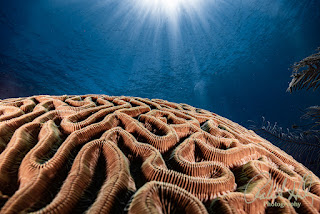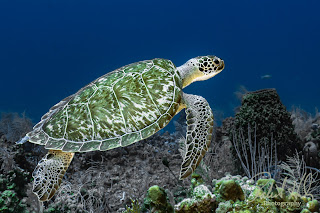Recovering Details in Wreck and Cavern Photography with Lightroom
Bringing Hidden Depths to Life
Few experiences compare to the exhilarating feeling of exploring beneath the surface, whether it's descending into a mysterious shipwreck or venturing into an untouched cavern. The scene is often breathtaking: beams of sunlight piercing through the blue water, creating shimmering patterns, while the shadows of beams and passageways gradually fade into intriguing darkness, inviting curiosity and adventure. However, capturing this awe-inspiring environment through photography presents its own challenges. When you upload your images, the scene's vivid drama can sometimes diminish. Bright highlights around the entry points may turn into a harsh, white-hot glow, and the interior details, rich with textures and subtle shadows, can be lost, swallowed by overwhelming darkness.
Luckily, modern photo editing software offers powerful tools to help recover those elusive details without compromising the atmosphere that makes these scenes so captivating. The latest versions of Lightroom, specifically Lightroom Classic 14.5.1, Lightroom (Cloud v8.5.1), and Lightroom Mobile v10.5, have introduced innovative features designed precisely for this purpose. These tools enable photographers and enthusiasts alike to enhance their images, carefully balancing exposure and recovering shadow and highlight details, all while maintaining the natural mood and depth of the scene.
In this comprehensive guide, we'll walk you through a practical workflow utilizing these advanced features. We will explore how to use HDR Merge to combine multiple exposures for a balanced overall tone, Shadows and Blacks recovery tools to bring out hidden details in darker areas, and AI Denoise technology to reduce noise without sacrificing image clarity or texture. By mastering this workflow, you can transform your challenging underwater or cavern images into stunning visuals that truly convey the wonder and mystery of those extraordinary environments.
Why This Matters
Wrecks and caverns challenge every underwater shooter:
- Extreme
dynamic range — bright openings vs. pitch-black interiors
- Suspended
particulates amplify noise when shadows are lifted
- Mixed
color temperatures from strobes and ambient light
Recovering interior detail in photographs without introducing unwanted grain or color casts is essential for transforming snapshots into publish-worthy images. Modern tools like Adobe Lightroom, particularly with its advanced AI-powered features, allow photographers and enthusiasts to achieve this with remarkable precision and ease. These tools enable non-destructive editing, meaning original image data remains untouched, so you can experiment and refine your edits without worry. Whether you're working on a high-resolution desktop setup or editing on a mobile device, Lightroom's AI capabilities help you consistently and professionally enhance interior details. This not only elevates the quality of your images but also streamlines your workflow, making it accessible and friendly for users at all skill levels, from hobbyists to professional photographers.
Step 1: Merge for Maximum Latitude — HDR Merge (⌘H / Ctrl H)
If you captured bracketed exposures (–2 / 0 / +2 EV), Lightroom's Photo > Photo Merge > HDR can combine them into a single DNG with up to 32-bit tonal range.
Workflow:
-
In Library or Develop, select the bracketed series.
-
Press ⌘H (Mac) / Ctrl H (Windows) → HDR Merge Preview.
-
Enable Auto Align (currents may have shifted your frame) and Deghost Medium to prevent diver motion blur.
-
Click Merge → Lightroom generates an HDR DNG ready for tone recovery.
Pro Tip: Shooting HDR underwater works best when using a tripod or perfectly neutrally-buoyant hover near fixed structure—like the wheelhouse railing of a wreck.
Step 2: Restore Tonal Balance — Light Panel Adjustments
Once merged, move to Develop > Light (Lr/LrC) or Light Panel (Mobile).
| Control | Purpose | Typical Range |
|---|---|---|
| Exposure | Match midtones to natural light | +0.3 – +0.7 |
| Highlights (⌥ / Alt drag) | Recover entry glow and bubbles | –60 to 90 |
| Shadows (⌥ / Alt drag) | Reveal interior ribs & debris | +50 to +80 |
| Blacks | Anchor contrast without crushing | –10 to –25 |
Press J to toggle clipping indicators—avoid blue (shadow) or red (highlight) warnings for balanced exposure.
Step 3: Precision Recovery with AI Masking
Modern AI masking (LrC 14.5 / Lr 8.5 / Mobile 10.5) automatically identifies scene components.
Suggested masks for wrecks/caverns:
-
Select Subject → isolates your diver or main object.
Apply Clarity +20, Texture +15, Dehaze +10 to restore crispness on tanks and gear. -
Select Background → the cavern walls or water columns.
Lift Shadows +35, Noise Reduction +20, lower Highlights –15. -
Linear Gradient → from the light opening downward.
Gently reduce Exposure –0.5 and add Temp +3 (warmer) for cinematic falloff.
Keyboard Shortcut: Shift + W opens the Masking panel instantly in Lightroom Classic.
Mobile Tip: Tap “Mask” > “Select Subject.” The same AI model runs locally, no cloud connection required.
Step 4: Suppress Noise — AI Denoise v2.0
When shooting at ISO 1600–3200 in tight spaces, even RAW files can look gritty.
In LrC / Lr / ACR:
-
Open Detail Panel > Denoise.
-
Click AI Denoise → Set Amount 40–60 for deep shadows.
-
Press Preview (P) to compare before/after.
On Mobile v10.5, manual Noise Reduction 30–40 and Detail +25 achieve similar smoothness.
Evidence: Adobe’s 2025 AI Denoise v2.0 (Camera Raw 17.5 engine) outperforms previous iterations, preserving >95 % of edge detail at identical ISO levels according to internal Adobe benchmarks.
Step 5: Reintroduce Depth — Tone Curve and Color Grading
Now that exposure is balanced, restore dimensionality.
Tone Curve:
-
Add a soft S-curve: drag mid-shadows down slightly, lift highlights up a touch.
-
Hold ⌘ / Ctrl while clicking to add anchor points precisely.
Color Grading:
-
Shadows: Add slight teal (H 190°, S 15).
-
Midtones: Add amber (H 45°, S 10) to simulate a filtered strobe.
-
Highlights: Neutral cool blue (H 210°, S 5).
This balances warm interior rust tones against cool ambient light seeping through entryways.
Step 6: Final Polish
| Task | Setting | Shortcut |
|---|---|---|
| Vignette | –10 to –20 in Effects Panel | none |
| Sharpening | Amount +40, Mask (hold ⌥/Alt) until only subject edges show | none |
| Crop/Straighten | Align vertical masts or corridor beams | R |
| Lens Corrections | Enable “Remove Chromatic Aberration” + “Profile Corrections” | Ctrl / ⌘ Shift C (copy settings) |
Export as DNG for re-edits, or as JPEG (100%) for posting.
Example Workflows in Action
Example 1: The Engine Room Glow
-
Setup: Canon R7 @ ISO 1600 / f2.8 / 1⁄60 sec with dual strobes.
-
Problem: Hot highlight at doorway; deep shadow behind bulkhead.
-
Solution: HDR Merge (+ 0 – 2 EV) → Shadows +70 → AI Denoise 50 → Color Grade amber midtones.
-
Result: Exposed machinery textures, balanced entry light.
Example 2: Cavern Exit Silhouette
-
Setup: Sony A7CR with ambient only.
-
Problem: Diver silhouette pure black; water blown out.
-
Solution: Linear Gradient (Exposure –0.8) on opening → Subject Mask + Shadows +80 → Dehaze +5.
-
Result: Dramatic separation, visible diver form, realistic sun-shafts.
Example 3: Smartphone Housing (SeaLife + iPhone 15)
-
Problem: HEIC compression is causing color banding.
-
Workflow: Lift Shadows +45 → Noise Reduction 35 → Point Color adjust cyan → warm Temp +8.
-
Result: Smooth gradient, restored bronze interior panels.
Tool Compatibility Chart
| Workflow Step | Lr Mobile v10.5 | Lr (Cloud) v8.5.1 | Lr Classic v14.5.1 | Photoshop / ACR v17.5 | Supported Formats |
|---|---|---|---|---|---|
| HDR Merge | ❌ (Not yet available) | ✅ | ✅ | ✅ via ACR Merge to HDR | RAW, DNG |
| Highlights/Shadows Recovery | ✅ | ✅ | ✅ | ✅ | All formats |
| AI Masking | ✅ | ✅ | ✅ | ✅ | RAW, DNG, JPEG, HEIC |
| AI Denoise v2.0 | ✅ (DNG only) | ✅ | ✅ | ✅ | RAW, DNG |
| Tone Curve & Color Grading | ✅ | ✅ | ✅ | ✅ | RAW, DNG, JPEG, HEIC |
| Export / Sync | ✅ | ✅ | ✅ | ✅ | All formats |
💻 Keyboard Shortcut Reference: Mac vs. Windows
Many Lightroom users switch between MacBooks and Windows laptops, so here's a quick guide to equivalent modifier keys used throughout this workflow:
| Action | macOS Key | Windows Key | Example Use |
|---|---|---|---|
| Command | ⌘ | Ctrl | ⌘H / Ctrl H → Merge to HDR |
| Option | ⌥ | Alt | Hold ⌥/Alt while dragging Blacks to view clipping |
| Shift | ⇧ | Shift | ⇧W → Open Masking Panel |
| Control | ⌃ | Ctrl | Used for contextual menus (Right-Click equivalent) |
| Reset a Slider | Double-click the slider name | Same | Resets Exposure, Shadows, etc. |
| Show Clipping Indicators | J | J | Toggles highlight/shadow warnings |
| Show Before/After View | \ (Backslash) | \ | Compare original vs. edited |
| Crop Tool | R | R | Opens Crop & Straighten panel |
| Copy Settings | ⌘⇧C | Ctrl Shift C | Copy adjustments between images |
🪸 Pro Tip: When using Lightroom Mobile, you can attach a Bluetooth keyboard—these same shortcuts apply on iPad and Android tablets running v10.5 or later.
Pro Tips for Oceanic Explorers
-
Bracket intentionally: At least ±2 EV for HDR latitude in wreck interiors.
-
Mind movement: Avoid stirring silt; particulate streaks multiply under HDR.
-
Shoot RAW (DNG): Enables AI Denoise and deeper color recovery.
-
Edit fresh: Adjust tones while your memory of the actual ambient color remains.
-
Cloud Sync: Start HDR merge on desktop, refine masks on mobile while traveling.
Why This Workflow Elevates Your Photography
By combining HDR Merge's tonal reach, AI Masking's precision, and AI Denoise's clarity preservation, this approach mirrors what the human eye experiences in a dim interior contrasted with bright open water. You're no longer choosing between "expose for the light" or "expose for the shadows"; you're doing both.
Your viewers will sense the authenticity: soft beams filtering through hatchways, corroded steel glowing faintly, the play of color where rust meets reef. These are the emotional textures that turn documentation into art.
Final Thoughts
Recovering details in wreck and cavern photos isn't about pushing sliders; it's about reconstructing the light narrative you experienced on the dive. Modern Lightroom tools give you scientific control with artistic freedom. Practice this workflow on your next set of wreck images, and you'll watch them transform from murky mysteries into illuminated stories.
📌 Learn more Lightroom techniques at info.robertherb.com/lm-3
📌 Share your before-and-afters with #RobertHerbPhotography
Until next time - dive smart, shoot sharp, and edit with intention.
- Bob Herb 📷 📷
🧭 What's Next?
🟦 Have you tried any of these techniques yet? Share your edits using #RobertHerbPhotography.
🟦 Want to see these workflows in action? Sign up for my upcoming training course at RobertHerb.com or reach out at bob@robertherb.com
🟦 And don't forget, new blogs drop weekly at Robert Herb Photography Blog
Written by Robert Herb – Empowering underwater photographers to capture and enhance the beauty of our oceans since 1978
Stay tuned for more in-depth insights into underwater photography. Let's dive deeper into the art and craft of capturing the marine world! If you have any comments or suggestions, I'd love to hear them.
Get ready for an exciting underwater photography adventure! For more details on my upcoming online training course, check out my "Training" page at RobertHerb.com or email me at bob@robertherb.com.
Sincerely,
Bob Herb
|
|





Comments
Post a Comment
Please let me know your comments.